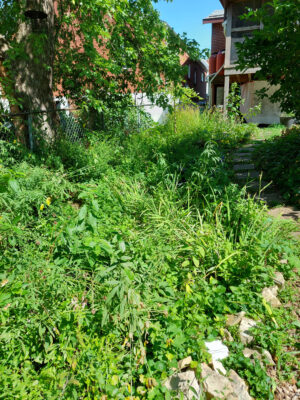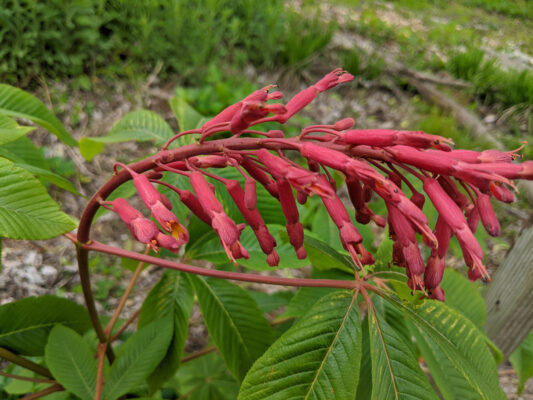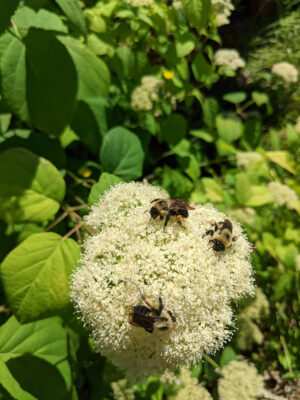post and photos by Besa Schweitzer, Chapter Member
introduction by Marsha Gebhardt, President
Some years ago Besa Schweitzer installed a rain garden in my backyard. The day after we got nine inches of rain at my Ferguson home I texted Besa to say ‘thank you!’ for my rain garden which not only gives me pleasure but has kept my basement dry. She said I was the third person to thank her that morning.
 I love to sit on my screen porch and watch the rain flow down from the gutters and fill up the rain barrels. We have a 300 gallon system and it fills quickly with a good rain. When the rain barrels overflow, the water goes into a rain garden. This rain garden is about a foot deep in the middle and 5 feet around. Soil from digging the rain garden was piled on the down hill side to form a dam and reinforced with a few big rocks. This area is planted with soft rush (Juncus effusus), queen of the prairie (Filipendula rubra) , hibiscus (Hibiscus spp.), and copper iris (Iris fulva).
I love to sit on my screen porch and watch the rain flow down from the gutters and fill up the rain barrels. We have a 300 gallon system and it fills quickly with a good rain. When the rain barrels overflow, the water goes into a rain garden. This rain garden is about a foot deep in the middle and 5 feet around. Soil from digging the rain garden was piled on the down hill side to form a dam and reinforced with a few big rocks. This area is planted with soft rush (Juncus effusus), queen of the prairie (Filipendula rubra) , hibiscus (Hibiscus spp.), and copper iris (Iris fulva). As the rain continues falling the rain garden fills up and overflows into a swale, which is a small foot wide ditch that directs the water flow to meander through the garden without washing out the paths. The winding swale keeps the water heading down hill while slowing it down and allowing it to absorb into the soil. The swale is invisible from above as the garden on both sides covers the gap.
The swale ends at the lowest part of the yard. In this area I have planted species that can tolerate temporary flooding. In the wettest part stands a red buckeye (Aesculus pavia) surrounded by seed box (Ludwigia alternifolia), blue eyed grass (Sisyrinchium spp.), and grey headed coneflower (Ratibida pinnata). Slightly higher up slope aromatic aster (Symphyotrichum oblongifolium) , purple coneflower (Echinacea purpurea), and blue stem goldenrod (Solidago caesia) grow.
The amount of stormwater flowing through my yard used to cause erosion and muddy spots in my lawn but now the water is encouraged to soak naturally into the soil. The deep roots of native plants help to move water into the lower layers of soil while the fibrous roots hold soil together to protect from erosion. Using native plants to control stormwater keeps creeks, basements, and driveways from flooding as well as proving natural water to the garden and the plants and wildlife that depend on it.
Visit Besa’s website for more information about rainscaping




